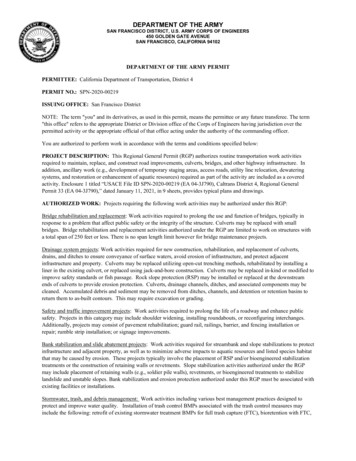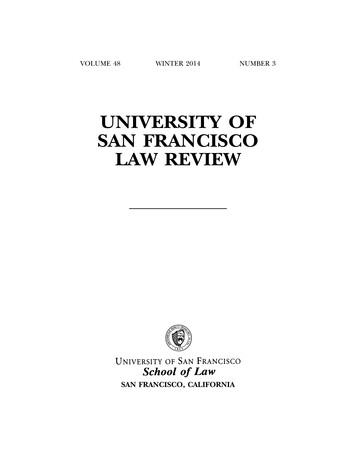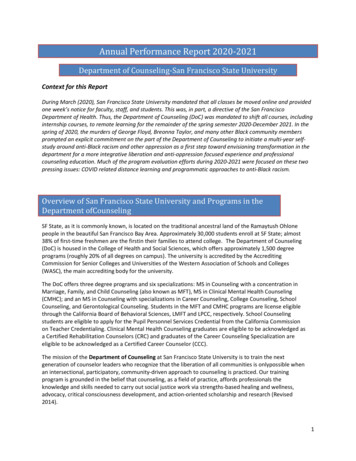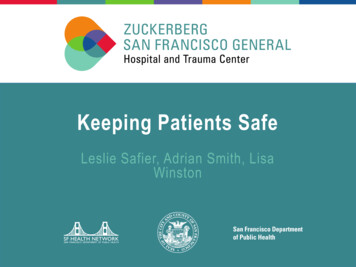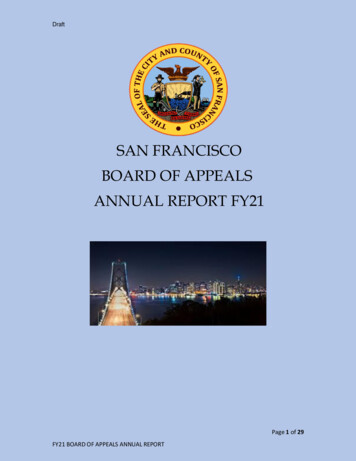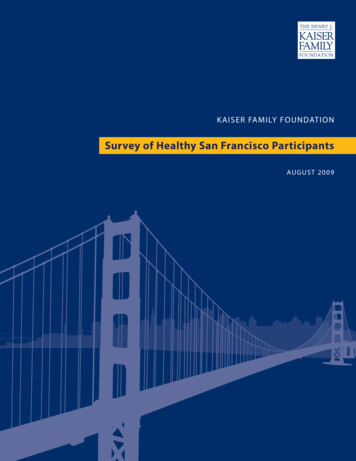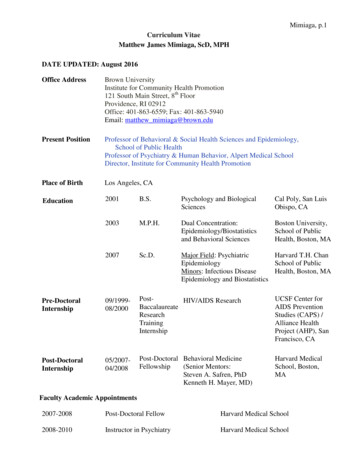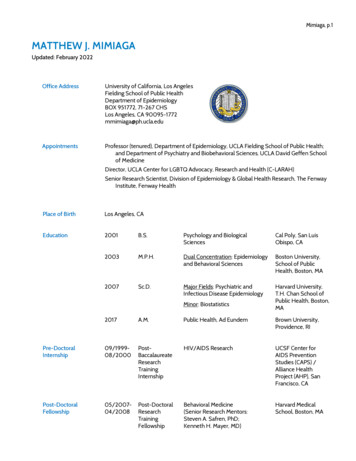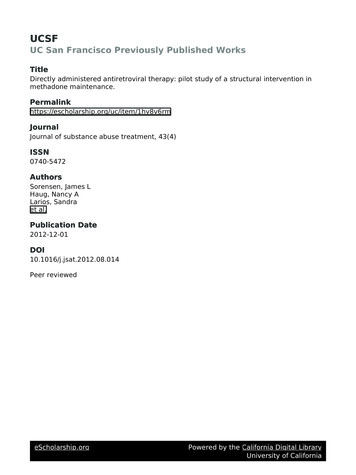
Transcription
UCSFUC San Francisco Previously Published WorksTitleDirectly administered antiretroviral therapy: pilot study of a structural intervention inmethadone tem/1hv8v6rmJournalJournal of substance abuse treatment, 43(4)ISSN0740-5472AuthorsSorensen, James LHaug, Nancy ALarios, Sandraet al.Publication Date2012-12-01DOI10.1016/j.jsat.2012.08.014Peer reviewedeScholarship.orgPowered by the California Digital LibraryUniversity of California
Journal of Substance Abuse Treatment 43 (2012) 418–423Contents lists available at SciVerse ScienceDirectJournal of Substance Abuse TreatmentDirectly administered antiretroviral therapy: Pilot study of a structural interventionin methadone maintenance , , James L. Sorensen Ph.D. a, b,⁎, Nancy A. Haug Ph.D. a, b, Sandra Larios Ph.D., M.P.H. a, b,Valerie A. Gruber Ph.D., M.P.H. a, b, Jacqueline Tulsky Ph.D. a, b, Elisabeth Powelson c,Deborah P. Logan R.N., C.N.S. b, Bradley Shapiro M.D. a, babcDepartment of Psychiatry, University of California, San Francisco, San Francisco, CA, USADepartment of Psychiatry, San Francisco General Hospital, San Francisco, CA, USAUniversity of California Berkeley – University of California San Francisco Joint Medical Program, Berkeley, CA, USAa r t i c l ei n f oArticle history:Received 9 March 2012Received in revised form 13 August 2012Accepted 13 August 2012Keywords:HIV/AIDSDrug abuse treatmentAntiretroviral therapya b s t r a c tDevising interventions to provide integrated treatment for addiction and medical problems is an urgent issue.This study piloted a structural intervention, Directly Administered Antiretroviral Therapy (DAART), to assistmethadone-maintenance patients in HIV medication adherence. Twenty-four participants received: (1)antiretroviral medications at the methadone clinic daily before receiving their methadone; (2) take-homeantiretroviral medication for days they were not scheduled to attend the methadone clinic, and (3) briefadherence counseling to address adherence barriers. DAART lasted 24weeks, with a planned step-down to twiceweekly administration in weeks 25–36, followed by self-administration in weeks 37–48. Retention rates at weeks24, 36, and 48 were 83, 92, and 75% respectively. DAART was associated with improvement in the proportion ofparticipants achieving viral suppression as well as with high medication adherence rates (clinic-verified; 85% andself-reported 97%) during the active intervention phase. DAART was effective as an intervention but did notpromote transition to self-administration. This study demonstrates that DAART is adaptable and simple enoughto be implemented into methadone treatment programs interested in providing HIV adherence services. 2012 Elsevier Inc. All rights reserved.1. IntroductionAdherence to HIV medications is crucial. It is well establishedthat adherence to antiretroviral (ARV) medications is associatedwith relative improvements in immunologic and virologic markers Financial Support: The research was supported by grants from the NationalInstitutes of Health (R21DA020369, P50DA09253, U10DA015815, and T32DA07250),and a Pilot Award from the UCSF AIDS Research Institute. These agencies had no role inthe study design, in the collection, analysis, and in the interpretation of data, in thewriting of the report, or in the decision to submit the paper for publication. Contributors: Authors Nancy A. Haug, James L. Sorensen, and Valerie A. Gruberdesigned the study. Authors Nancy A. Haug, Valerie A. Gruber, Elisabeth Powelson,Sandra Larios, Bradley Shapiro, and James L. Sorensen wrote the protocol. AuthorsElisabeth Powelson, Sandra Larios, and Valerie Gruber screened participants, collecteddata, and delivered the adherence counseling. Authors Jacqueline Tulsky, BradleyShapiro, and Deborah P. Logan delivered and supervised medical and substance abusetreatment issues related to the study activities. Authors Sandra Larios and Valerie A.Gruber oversaw the data quality and data analysis activities. Author James Sorensenwrote the first draft of the manuscript with assistance from authors Nancy A. Haug,Sandra Larios, and Valerie A. Gruber. All authors have approved the final manuscript. Conflict of Interest: No conflicts declared.⁎ Corresponding author. Department of Psychiatry, University of California, SanFrancisco, San Francisco General Hospital, Building 20, Room 2117, 1001 PotreroAvenue, San Francisco, CA 94110, USA. Tel.: 1 415 206 3969; fax: 1 415 206 5233.E-mail address: james.sorensen@ucsf.edu (J.L. Sorensen).0740-5472/ – see front matter 2012 Elsevier Inc. All rights 014(Low-Beer, Yip, O'Shaughnessy, Hogg, & Montaner, 2000; Patersonet al., 2001), increased body weight (Shikuma et al., 2004), andless rapid progression to acquired immunodeficiency syndrome(AIDS) (Bangsberg et al., 2001). Substance abuse is consistentlyassociated with low adherence to HIV medications (Gonzalez,Barinas, & O'Cleirigh, 2011; Lucas, 2011). Preventive interventionsinclude patient-centered, behavioral skill approaches and environmental interventions that facilitate adherence, such as directlyadministered antiretroviral therapy (DAART). DAART's main components include supervised medication administration, which involves structural clinical changes (Blankenship, Bray, & Merson,2000), and individual patient support. Methadone maintenancetreatment (MMT) programs are promising sites for using DAART.Staff are licensed to administer medications, and patients attend theclinics frequently, often daily. The efficacy of on-site dispensing oftuberculosis medications in MMT has been demonstrated (Batki,Gruber, Bradley, Bradley, & Delucchi, 2002), and positive effects ofDAART in MMT have been shown (Lucas et al., 2006). A recentclinical trial found higher adherence and lower viral loads in theDAART group (Berg, Litwin, Li, Moonseong, & Arnsten, 2011) compared to treatment as usual.Recent clinical guidelines for improving entry, retention, andantiretroviral adherence developed by an International Association of
J.L. Sorensen et al. / Journal of Substance Abuse Treatment 43 (2012) 418–423Physicians in AIDS Care Panel (Thompson et al., 2012) recommendDAART for individuals with substance use disorders. Specifically,integration of DAART into methadone maintenance treatment foropioid dependent patients is advised. Yet implementing DAART inmethadone clinics confronts a number of barriers. The need for stafftime to coordinate with the primary medical provider and thepharmacy; specific protocols for a wide range of procedures such ashandling, storing, dispensing, and implementing changes in medications; and patient no-shows causing not only missed methadonedoses but also missed ARV medications, are significant barriers wehave observed.The present study was conducted to assess the feasibility andeffectiveness of providing DAART in a methadone clinic setting. Theprimary expectation was that DAART would be associated with anincrease in the proportion of participants who achieved viralsuppression. In a related secondary hypothesis we expected thatadherence to ARV medication would improve.2. Methods2.1. ParticipantsTwenty-four adult opioid-dependent patients in MMT at the SanFrancisco General Hospital (SFGH) were included, all receiving orstarting ARV therapy. Inclusion criteria were: detectable viral load,prescribed once-or-twice-daily ARV dosing, clinic methadone dosingschedule at least three times a week, and reported less than 95%adherence to ARVs during a 2-week baseline period. Exclusion criteriawere: enrolled in another adherence program or residential treatment, cognitive impairment or psychosis interfering with ability toprovide informed consent, or unavailable any time during the 48week study period.2.2. Study siteThe SFGH Opiate Treatment Outpatient Program (OTOP) is a600-patient clinic providing MMT and outpatient detoxification.OTOP has treated patients with HIV/AIDS since 1984 (Sorensen,Batki, Good, & Wilkinson, 1989) and provides HIV primary care to80 patients. Adding DAART to the clinic's services involvedconsiderable preparation, including presentation to clinic staff,surveying staff to understand the barriers to conducting DAART,adapting an adherence counseling manual (Haug, Sorensen,Gruber, Lollo, & Roth, 2006) to include standardized DAARTelements, educating clinic staff about HIV treatment, and developing procedures for administering HIV medications at the busyMMT dispensary.2.3. Recruitment and informed consentThe UCSF IRB approved all study procedures. Recruitment methodswere based on previous work at the clinic (Sorensen et al., 2007).Participants consented to the DAART intervention and to exchange ofinformation with primary care providers concerning viral load testsand missed ARV doses. Participants were enrolled from September 12,2007 through September 30, 2008.4192.5. The DAART interventionDAART was provided for 24 weeks. Following referral by theirprimary care provider and review by the methadone clinic nursepractitioner or physician to address possible interactions andneeds for methadone does adjustments, participants took theirARV medications at the MMT clinic's dispensing window beforereceiving methadone.The procedures used were streamlined and adapted to fit theclinical setting. Although we had originally planned to conduct a studyof “enhanced” DAART (see Altice et al., 2004), it was difficult toemploy many of these components in the clinic. For example, it wasnot feasible to employ a DAART specialist a position that coordinatedcare, outreach workers, or a HIV clinical pharmacist (Foisy & Akai,2004) to perform adherence counseling; consequently these responsibilities were absorbed by the clinical and research staff. We alsoincorporated staff trainings on the project rationale, procedures, andoutcomes to assist with organizational acceptability.We adopted structural elements to address observed barriers: (1)take-home antiretroviral medication packets for days the participantswere not scheduled to attend MMT and (2) extra medication ifparticipants did not attend on scheduled days. By ensuring thatparticipants always had access to their HIV medication, theseprocedures enabled the clinic to provide DAART to those whose clinicattendance was not ideal. Specifically, participants received packetscontaining HIV medications for evenings and days they were notscheduled to attend clinic, plus emergency packets for up to 7 days ofmissed clinic visits. A backup prescription for an additional 7-daysupply was kept on file with the participating pharmacy as anemergency back-up. Additional medications could be included inDAART and in emergency packets by primary provider request.After 24 weeks of DAART, participants transitioned to twiceweekly direct administration, with self-administration on the otherdays (DAART step-down), and after 36 weeks they transitionedentirely to self-administration. However, as noted in the resultssection, the step-down process was not feasible for most participants,who continued to receive DAART with methadone. Participants, theirprimary care providers, methadone clinic staff, and the adherencecounselor could suggest continuation in the regular DAART protocolinstead of step-down transition to self-administration. Often participants asked to continue in DAART, or primary providers requestedcontinued DAART for participants on salvage regimens for whomdeveloping resistance entailed high medical risk.In addition to DAART, brief adherence counseling was provided bya research project assistant with a bachelors' degree in psychology,with supervision and backup by clinical psychologists (authors VGand JS). The approach was cognitive–behavioral, supportive, andpsychoeducational with elements of motivational interviewing (seeCooperman, Parsons, Chabon, Berg, & Arnsten, 2007; Haug et al.,2006). The goal was to help participants take their at-home doses,and prepare for step-down from DAART. Adherence counselingsessions were scheduled in coordination with methadone dosing(i.e. the days and times participants came for dosing) and inconjunction with study visits.Adherence counseling began in study week 1 and occurred everyother week during DAART and every 4 weeks during DAART stepdown phase. Each session lasted about 15 minutes and includedassessment of adherence, addressing barriers to adherence, and aclient adherence assignment.2.4. Study procedures2.6. MeasuresParticipants completed a baseline assessment and providedblood and urine samples. They supplied detailed tracking informationat baseline and every 4 weeks. Self-report measures were gatheredthrough an audio computer assisted self-interview (A-CASI) at14-day intervals.2.6.1. Background and follow-up measuresBarriers to adherence checklist (Catz, Kelly, Bogart, Benotsch, &McAuliffe, 2000) include 56 items scored on a four-point scale rangingfrom 4 (definitely true) to 1 (definitely false), with higher scores
J.L. Sorensen et al. / Journal of Substance Abuse Treatment 43 (2012) 418–423indicating higher barriers to adherence, resulting in a possible rangefrom 4 to 224.Substance use was measured using the timeline followbackassessment (Sobell & Sobell, 1992) for the previous 14 days(2 weeks) at baseline. For the 12, 24, and 48 week analyses numberof days using out of the past 28 (4 weeks) was analyzed. We thendichotomized substance use into high (using on more than 1/3 ofdays) and low (using on less than 1/3 of the days) categories toaddress variable skewedness. This cutoff was chosen based on thedistribution of the variables; many participants were either usingheavily or not at all.10086907680807970Percent42060504030201002.6.2. Outcome measuresA timeline followback calendar procedure yielded self-reportedadherence for the previous 2 weeks. MMT dispensing records wereabstracted to document the proportions of days medications weretaken as prescribed. Plasma HIV-1 RNA (viral load) was determinedusing version 3.0 branched DNA assay with a lower limit of 75 copiesper milliliter, and was measured at baseline and weeks 12, 24, 36, and48. Undetectable viral load was defined as less than 75 copies permilliliter of plasma.Most were receiving long-term disability (SSI) and Medicaid, and theremaining participants were on general assistance.2.7. Monetary compensation3.2. RetentionParticipants received cash compensation for study activities,including each assessment ( 15), blood draw ( 5), urine sample( 3), and a 25 bonus for completing all assessments on time.Regarding retention in the study, 21 (87.5%) of the 24 participantscompleted the 12-week assessment, 20 (83%) completed 24-weekassessment, 22 (92%) completed 36-week assessment and 18 (75%)completed the 48-week assessment. Viral load data were obtained formore participants, including 21 participants (87.5%) at 12 and 24weeks,20 participants (83.3%) at 36weeks, and 19 participants (79.2%) at48weeks. Of those who dropped out of the study, the primary reasonswere: left MMT and could not be located (three participants) andincarceration (two participants). Number of participants completingweekly assessments ranged from 23 (96%) in week 6 to 13 (54%) inweek 40 and averaged 18 participants (75%) through the study.Regarding retention in the intervention, all 24 participantscompleted the 2-week baseline phase, and 17 (71%) completed theinterventions (DAART through 24 weeks, followed by DAART stepdown or transition to long-term clinic DAART). Of the participantswho discontinued treatment, primary reasons were: discontinuedMMT (three participants) and transferred to another MMT program(two); one went to prison, and only one discontinued DAART. At theend of the study intervention phase, the MMT program voluntarilycontinued the DAART process with nine participants, two werereceiving DAART in hospice or residential care, and six participantshad transitioned to self-administration.2.8. Data analysis2.8.1. Data quality and data reductionThe ARV medication doses received or missed were obtained fromthe methadone dispensary records and databases. These werechecked against the research assistant's daily log. With self-reportedadherence we compared the number of doses missed during the 2week baseline with the most recent 2 week (14 days) follow-ups at 24and 48 weeks. We also compared the self-reported percentage ofdoses taken over the 2-week baseline with the percentage taken inthe period covered by each follow-up. Listwise deletion was used tohandle missing data.2.8.2. Statistical analysesComparisons between baseline and 24-week data examined initialeffects of the intervention, and comparisons between baseline and 48weeks explored the sustained impact of the intervention. Viral loaddata had a skewed distribution, so the distribution was dichotomized(detectable, undetectable), and McNemar's chi square statistic wasused to test for changes between baseline and 12-weeks. Similaranalyses were used to examine differences between baseline and 24,36, and 48-week viral load (Fig. 1).3. Results3.1. Cohort description3.1.1. RecruitmentOf 66 participants referred, 32 (48.5%) were ineligible (e.g.undetectable viral load, on methadone van, discharged from methadone maintenance since referral), and another 10 (15.2%) declinedto participate.3.1.2. Participant characteristicsBackground characteristics of participants appear in Table 1. Asnoted, most participants were male, they came from varied racial/ethnic backgrounds with about 28% nonwhite, over 80% self-identifiedas heterosexual; and in age over two thirds were in their 40s or 50s.0Baseline(n 24)12 Weeks 24 Weeks 36 Weeks 48 Weeks(n 21)(n 21)(n 20)(n 19)Study VisitFig. 1. Percent achieving viral suppression over time.3.3. Participation in adherence counselingOf the 13 adherence counseling sessions expected during the 24week DAART phase, mean attendance was 11.1; 14 participants (58%)completed all 13 expected sessions. All 6 who continued to the stepdown phase and 7 of the 9 who continued to long-term DAART providedby the methadone clinic completed all adherence counseling sessions.Ten participants completed fewer sessions than intended. Of these,6 had favorable or neutral outcomes, including 1 who chose todiscontinue DAART, 2 who continued to long-term DAART, 2 whotransferred to other methadone clinics, and 1 who transferred to HIVresidential care with onsite DOT. Another 4 had unfavorable outcomes, including 3 who were discharged from the methadone clinicfor nonattendance or behavior problems, and 1 who was incarcerated.Between Weeks 24 and 36, an additional 3 adherence counselingsessions were scheduled for the 17 participants who went on to thestep-down phase or to clinic DAART. Of the 6 in the step-down phase,1 (16.7%) had only 2 of the 3 adherence counseling sessions, and of the9 who transitioned to long-term clinic DAART, 2 (22.2%) had only 2 of
J.L. Sorensen et al. / Journal of Substance Abuse Treatment 43 (2012) 418–423Table 1Participant background characteristics.Baseline demographic and clinical characteristics (N 24)Gender, n (%)MaleFemaleTransgenderRace/ethnicity, n (%)WhiteBlackHispanicOtherSexual orientation, n (%)HeterosexualHomosexualBisexualAge, mean (SD)Highest level of educationSome high school or lessHigh school diploma or GEDSome collegeCurrent employment statusEmployed (full time or part-time)UnemployedRetiredMarital statusSingleMarriedDivorcedSeparatedWidowedLiving arrangementsWith significant otherWith family (not own children)With friendsAloneResidential facilityHomeless, n (%)Viral load, n rs since diagnosis, n (%)b1 year1–9 years10–19 years20 yearsYears in methadone maintenance, n (%)b1 year1–9 years10–19 yearsSubstance use in past 14 days, mean pinesMethamphetamineProportion of high (N1/3) substance use days, n inesMethamphetamine14 (58)8 (33)2 (8)10 (42)6 (25)7 (29)1 (4)20 (83)2 (8)2 (8)44.1 (9.4)13 (54)9 (38)2 (8)015 (63)9 (38)12 (50)05 (21)1 (4)6 (25)5 (21)3 (13)5 (21)8 (33)3 (13)10 (42)1 (4)6 (25)12 (50)5 (21)1 (4)8 (33)13 (54)2 (8)11 (46)10 (42)3 (13)3.3 (5.2)4.3 (5.3)0.6 (1.1)5.5 (5.8)5.4 (5.9)2.1 (4.3)0.3 (0.6)5 (21)4 (17)07 (29)7 (29)2 (8)0the 3 sessions (decreased frequency while in residential treatment).All others completed all 3 intended sessions.3.4. Adherence-related subjective experiencesAs Table 2 shows, DAART was associated with decreased barriersto adherence. Ratings improved from baseline to the 24-week421interview and remained stable though the 48-week interview.Participants identified several barriers to adherence at baseline(principally “getting treatment reminds me that I am HIV ” and “Ihave trouble remembering the names of medicines and what they arefor”). The number of barriers declined slightly by the 24-weekinterview and stayed at this level through the 48-week interview.3.5. Medication adherenceDAART was associated with improved adherence. Dispensingrecords (Table 2) indicate that during the 24-week DAART phaseparticipants took 84% of their HAART doses. For the participants whotransitioned to the DAART step-down phase (n 6) (Weeks 24 to 36)adherence increased to 96%.Participants' self-report of adherence also improved significantlyfrom baseline to the 24-week follow-up and was maintained throughthe 48 week follow-up. Table 2 shows the percentage of days takingmedications (days of adherence) in the 14 days before the assessment.Allowing time for stabilization over the first 12 weeks, in the second12 weeks leading up to the 24-week assessment, participants reportedan average of 94% adherence, compared to an average of 36% atbaseline. There were no significant adherence differences betweenthose individuals who transitioned into the step-down phase andthose who did not.3.6. Plasma HIV-1 RNA (viral load) (primary outcome)Fig. 1 displays the proportion of participants who achieved viralsuppression from baseline through week 48. DAART was associatedwith viral load reduction. At baseline 0% of participants hadundetectable viral loads. By 12 weeks 86% of the participants alreadyhad undetectable levels. McNemar's test indicated significant changebetween baseline and each subsequent time point, including asustained difference at 48 weeks (pb.001).3.7. Substance use associations with self-reported HAART adherenceThe proportion of days of substance use was calculated, allowingcomparisons between the 2-week baseline and the 24-week followup. For each substance, participants were then grouped into thosewith high use (used more than 1/3 of the days in the reporting period)and low use (used on 1/3 or fewer of the days in the reporting period).At baseline, those with high opioid use reported missing fewerdays of their HIV medications (mean days of missed medications 3.78) than those with low opioid use (mean days of missedmedications 12.07), [F(1,23) 18.71, pb.001]. No adherence differences were found in high vs. low alcohol [F(1,23) 0.63, ns] orcocaine users [F(1,23) 0.09, ns]. Baseline data showed that of the 24participants 5 (21%) were categorized as high alcohol users, 7 (29%)were high cocaine users, and 7 (29%) were high opiate users (Table 1).At 24 weeks no adherence differences were found between high andlow opioid [F(1,14) 0.62, ns], alcohol [F(1,14) 3.34, ns], or cocaineusers [F(1,14) 0.07, ns]. At 24 weeks we had substance use data for15 participants. Of these, three participants (20%) had high alcoholuse, four (27%) reported high cocaine use, five (33%) reported highopiate use, and two reported high marijuana use (13%). Noparticipants reported high methamphetamine, high heroin, or highbenzodiazepine use at 24 weeks.3.8. Participants who transitioned to step-down and self-administrationOf the six participants who transitioned to step-down and thenself-administration, almost all were housed (n 5, 83.3%, vs. only58.3% housed in the overall sample) and ethnic minority (n 5, 83.3%,vs. only 28% minority in the overall sample). There were an equalnumber of men and women. There were no significant substance use
422J.L. Sorensen et al. / Journal of Substance Abuse Treatment 43 (2012) 418–423Table 2Participant adherence background and outcomes.VariableAdherence-related subjective experiencesBarriers to adherenceAdherenceMedication dispensing records—percentof doses takenSelf-reported adherence–percent ofdays adherentBaseline(N 24)Mean (SD)24 weeks(n 20)Mean (SD)48 weeks(n 18)Mean (SD)Absolute meandifferenceBaseline–24 weeksT-test statistic,(df) Baseline–24 weeksAbsolute meandifferenceBaseline–48 weeksT-test statistic,(df) Baseline–48 weeks111.3 (27.7)89.1 (21.7)78.9 (20.2)22.24.4⁎, (17)32.44.7⁎, (15)n/a8485n/an/an/an/a36 (43)94 (22)99 (2)58 5.2⁎, (19)63 6.0⁎, (17)⁎ pb.001.or adherence differences between those who transitioned and thosewho did not.3.9. Clinic continuation on DAART after end of study interventionThe methadone clinic transitioned nine participants to long-termDAART at the methadone dispensary window. At 6 months past theend of the 48-week study, these nine participants were still receivingtheir ARVs at the dispensary window.Because of clinic budget limitations and the less certain benefits ofadherence counseling, the clinic did not to continue the regularadherence counseling. Instead, a nurse practitioner provided pharmacy coordination (prescription changes and problem resolution),and as-needed adherence counseling.4. DiscussionThe present study contributes to existing DAART literature byproviding programmatic data that shows that DAART is adaptable andsimple enough to be a highly generalizable model for other MMTprograms interested in providing HIV adherence services. This workpiloted DAART, an intervention that included directly dispensingARVs in MMT and individual adherence counseling. DAART, withconvenience packets for at-home ARV doses and missed visits,supplemented by adherence counseling and pharmacy coordination,increased ARV adherence despite substance use and homelessness.DAART had acceptable retention (75% continued through 24 weeks);was associated with greatly improved adherence to HIV medications;and the proportion of participants with undetectable viral loads rosefrom 0 to 86%. Attempts to step participants down from DAART weremixed. At 24 weeks, when the step-down phase began, there were nodifferences observed between those who began step-down and thosewho did not. Only 6 of the 24 participants succeeded in transitioningto self-administration. Almost all of those had stable housing, and amajority were ethnic minorities. The MMT program voluntarilycontinued the DAART process with nine participants after theintervention ended, reflecting positive perceptions by both participants and clinic staff. These results mirror other demonstrations (Berget al., 2011; Conway et al., 2004; Lucas et al., 2006) that MMT can be auseful site for DAART interventions.In this study, the modal participant continued DAART beyond theplanned 24-week intervention period. The planned step-down fromDAART to self-administration was not feasible for most participants.DAART served as a long-term rather than a short-term intervention,despite adherence counseling designed to help participants achieveself-administration. These results are congruent with a trial of DAARTversus self-administered therapy among injection drug users (Altice,Maru, Bruce, Springer, & Friedland, 2007), which demonstrated theeffectiveness of DAART at improving 24-week outcomes, yet virological benefits did not persist after the intervention ended (Maru, Bruce,Walton, Springer, & Altice, 2009). These results are consistent with theidea that DAART should be considered a long-term interventionbecause the benefits for adherence and viral load cease once DAART isdiscontinued (Berg et al., 2011). A positive aspect of this study is thatthe structural aspects of the intervention, including staff training andidentifying DAART barriers at the clinic, coupled with significantimprovements in patients on DAART, helped the clinic to adopt thisintervention beyond the planned research study.Study limitations included the small sample size, which preventedexamining independent contributions of intervention componentsand predictors of response to DAART. So we are uncertain about theindependent or combined contribution of supervised dosing, andadherence counseling. Generalizability was limited by the singleclinic setting, and we note that only 24 of 68 people referred to thestudy participated. Longer-term efficacy is unknown at this time. Themeasure of adherence to take-home medications depended on selfreport, which is a limited measure of medication adherence.Surprisingly, at baseline the high users of opioids self-reported betteradherence than the low-users of opioids, a counterintuitive findingthat should be investigated using a more objectively observablemeasure of medication adherence. Also there was no comparisongroup. We also note that transition from DAART to self-administrationwas not achieved and may have been an unreasonable expectation.Despite the study's restrictions, this work adds to a growingliterature demonstrating the value of integrating HIV treatment intoMMT programs and substance abuse treatment in general. RecentlyVolkow and Montaner (2011) point out the vital importance ofproviding comprehensive care for drug users with HIV, integratingtreatments of addiction and medical problems. The present studysupports the conclusion that adherence to HIV medications can beimproved with the use of DAART. By implementing DAART, methadone clinics can help patients to take their ARVs as scheduled, despiteadherence challenges such as substance use and homelessness. Thisallows patients who may otherwise be deemed too unstable to receiveARVs, decreasing their viral load and HIV disease progression.Implementing DAART services in an MMT program requirescl
antiretroviral medications at the methadone clinic daily before receiving their methadone; (2) take-home . Francisco, San Francisco General Hospital, Building 20, Room 2117, 1001 Potrero Avenue, San Francisco, CA 94110, USA. Tel.: 1 415 206 3969; fax: 1 415 206 5233.
